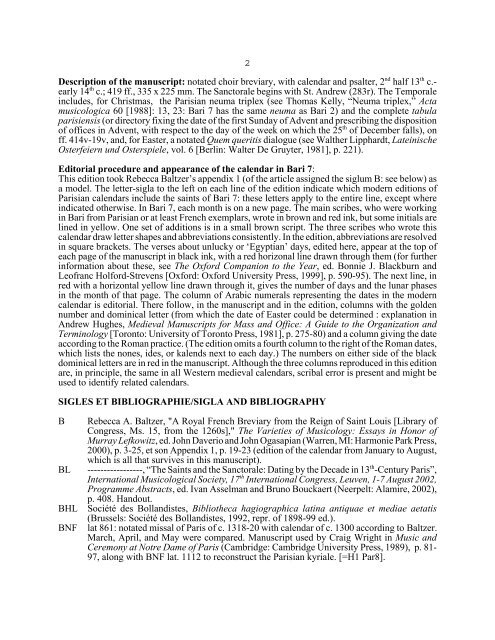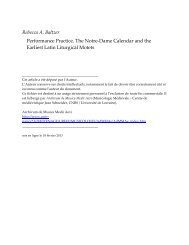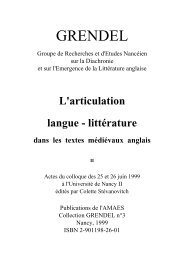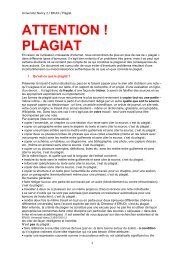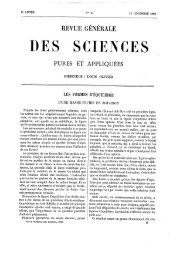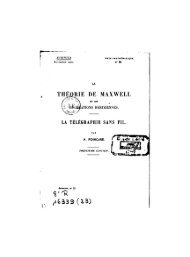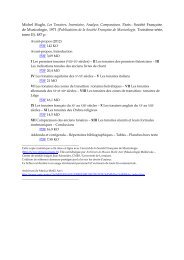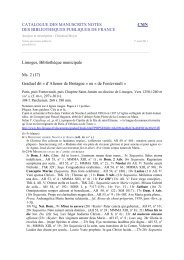Barbara HAGGH-HUGLO - Université Nancy 2
Barbara HAGGH-HUGLO - Université Nancy 2
Barbara HAGGH-HUGLO - Université Nancy 2
You also want an ePaper? Increase the reach of your titles
YUMPU automatically turns print PDFs into web optimized ePapers that Google loves.
2<br />
Description of the manuscript: notated choir breviary, with calendar and psalter, 2 nd half 13 th c.-<br />
early 14 th c.; 419 ff., 335 x 225 mm. The Sanctorale begins with St. Andrew (283r). The Temporale<br />
includes, for Christmas, the Parisian neuma triplex (see Thomas Kelly, “Neuma triplex,” Acta<br />
musicologica 60 [1988]: 13, 23: Bari 7 has the same neuma as Bari 2) and the complete tabula<br />
parisiensis (or directory fixing the date of the first Sunday of Advent and prescribing the disposition<br />
of offices in Advent, with respect to the day of the week on which the 25 th of December falls), on<br />
ff. 414v-19v, and, for Easter, a notated Quem queritis dialogue (see Walther Lipphardt, Lateinische<br />
Osterfeiern und Osterspiele, vol. 6 [Berlin: Walter De Gruyter, 1981], p. 221).<br />
Editorial procedure and appearance of the calendar in Bari 7:<br />
This edition took Rebecca Baltzer’s appendix 1 (of the article assigned the siglum B: see below) as<br />
a model. The letter-sigla to the left on each line of the edition indicate which modern editions of<br />
Parisian calendars include the saints of Bari 7: these letters apply to the entire line, except where<br />
indicated otherwise. In Bari 7, each month is on a new page. The main scribes, who were working<br />
in Bari from Parisian or at least French exemplars, wrote in brown and red ink, but some initials are<br />
lined in yellow. One set of additions is in a small brown script. The three scribes who wrote this<br />
calendar draw letter shapes and abbreviations consistently. In the edition, abbreviations are resolved<br />
in square brackets. The verses about unlucky or ‘Egyptian’ days, edited here, appear at the top of<br />
each page of the manuscript in black ink, with a red horizonal line drawn through them (for further<br />
information about these, see The Oxford Companion to the Year, ed. Bonnie J. Blackburn and<br />
Leofranc Holford-Strevens [Oxford: Oxford University Press, 1999], p. 590-95). The next line, in<br />
red with a horizontal yellow line drawn through it, gives the number of days and the lunar phases<br />
in the month of that page. The column of Arabic numerals representing the dates in the modern<br />
calendar is editorial. There follow, in the manuscript and in the edition, columns with the golden<br />
number and dominical letter (from which the date of Easter could be determined : explanation in<br />
Andrew Hughes, Medieval Manuscripts for Mass and Office: A Guide to the Organization and<br />
Terminology [Toronto: University of Toronto Press, 1981], p. 275-80) and a column giving the date<br />
according to the Roman practice. (The edition omits a fourth column to the right of the Roman dates,<br />
which lists the nones, ides, or kalends next to each day.) The numbers on either side of the black<br />
dominical letters are in red in the manuscript. Although the three columns reproduced in this edition<br />
are, in principle, the same in all Western medieval calendars, scribal error is present and might be<br />
used to identify related calendars.<br />
SIGLES ET BIBLIOGRAPHIE/SIGLA AND BIBLIOGRAPHY<br />
B<br />
BL<br />
BHL<br />
BNF<br />
Rebecca A. Baltzer, "A Royal French Breviary from the Reign of Saint Louis [Library of<br />
Congress, Ms. 15, from the 1260s]," The Varieties of Musicology: Essays in Honor of<br />
Murray Lefkowitz, ed. John Daverio and John Ogasapian (Warren, MI: Harmonie Park Press,<br />
2000), p. 3-25, et son Appendix 1, p. 19-23 (edition of the calendar from January to August,<br />
which is all that survives in this manuscript).<br />
-----------------, “The Saints and the Sanctorale: Dating by the Decade in 13 th -Century Paris”,<br />
International Musicological Society, 17 th International Congress, Leuven, 1-7 August 2002,<br />
Programme Abstracts, ed. Ivan Asselman and Bruno Bouckaert (Neerpelt: Alamire, 2002),<br />
p. 408. Handout.<br />
Société des Bollandistes, Bibliotheca hagiographica latina antiquae et mediae aetatis<br />
(Brussels: Société des Bollandistes, 1992, repr. of 1898-99 ed.).<br />
lat 861: notated missal of Paris of c. 1318-20 with calendar of c. 1300 according to Baltzer.<br />
March, April, and May were compared. Manuscript used by Craig Wright in Music and<br />
Ceremony at Notre Dame of Paris (Cambridge: Cambridge University Press, 1989), p. 81-<br />
97, along with BNF lat. 1112 to reconstruct the Parisian kyriale. [=H1 Par8].


